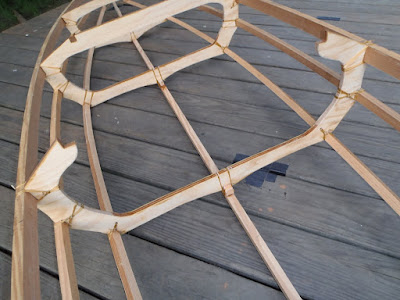Last spring, in preparing for
my summer boat-building day camp at St. Andrew's Episcopal Church, I built a
small paddling boat to test my ideas and get a feel for how it might work with
kids. The result was very heavy and
clunky, and taught me how NOT to build a simple hull. This year I was invited to give the program
again but with middle-school youth, so I decided a more sophisticated boat was
in order.
One of the boats built in the St. Andrew's Summer program.
I've become interested
in the modern versions of skin-on-frame boats that were originally developed by
the peoples of the far north, such as those known variously as Eskimos, Innuit,
Aleut and Yupik. Their seal-skin-covered boats, evolved
in an environment where wood was incredibly scarce, ended up with hulls that
were seaworthy yet very light--superior in many ways to those of the Europeans who
first encountered them a couple of centuries ago. The modern versions of these kayaks take full
advantage of the properties of plywood for shaping the hull, and the durability
and ease of use of nylon or polyester cloth for covering. They have developed a reputation for
lightness, durability, and--perhaps most importantly-- relatively fast and
inexpensive construction.
I have already built a
two-man kayak that is quite good-looking and functional, yet--even though it is
made mostly of expensive and light-weight 3/16-inch plywood--is still a bit
heavy to for loading single-handed on the minivan roof rack.
A skin-on-frame kayak involves
(I thought) less use of dangerous edge tools and has jobs such as cutting out frames
and tying lashings, that could occupy a fair-sized group of kids
simultaneously--important values for my program. Of course, I would have to build one first so
I could program and organize the build into the time available and teach kids
the necessary skills; and that--wouldn't you know--would give me a kayak of my
own! Several "professional amateur" designers offer skin-on-frame designs. After settling on Dave Gentry's Chuckanut kayak, I wrote to him about the St. Andrew's summer camp program--he promptly donated a set of plans, even paying the postage! (I bought the plans for the one-man kayak I am building for myself; Dave then donated the plans for a two-man kayak the kids will build.)
Progress so far--
I have been working rather
slowly and fitfully, having cut out the frames with a jigsaw and ripped the
long stringers on a table saw months ago.
I only just finished tying the lashings that make frames and stringers
into a stiff and stable whole. I still
have to install the carlins that will define the cockpit edge, and a deck beam
that will provide a stable place to attach things. Once these are done I can "skin"
the boat with heat-shrink polyester, shrink it taut with a hot iron, and paint
the fabric to make it waterproof. All
that must happen in the next few weeks to be ready for the program, which
begins in July. On the other hand, I may put off skinning the boat until the program is well under way in mid-July--that way the kids can see the critical steps and goals before they have to perform them.The end frames and keel begin attached to a "strong-back" of 2X4 pine to keep everything aligned in the beginning.
Figure-eight and over-hand knots secure the end of the "artificial sinew" used to tie stringers into notches in the frames.
This open-ended frame makes for a generously-sized cockpit.
Stems are secured to the gunwales, keel, and other stringers by a combination of screws, epoxy, and lashings.









These are nice looking boats, and hard to beat for fun and utility. I heard that these skin on frame kayaks are perfect for whitewater. I hope your design can help us to make more fun into the water. I'll wait for this version.
ReplyDeletesea kayak
Jazz,
DeleteDunno about white water--good question for the designer: Dave Gentry at http://gentrycustomboats.com/Home.html
Jeff